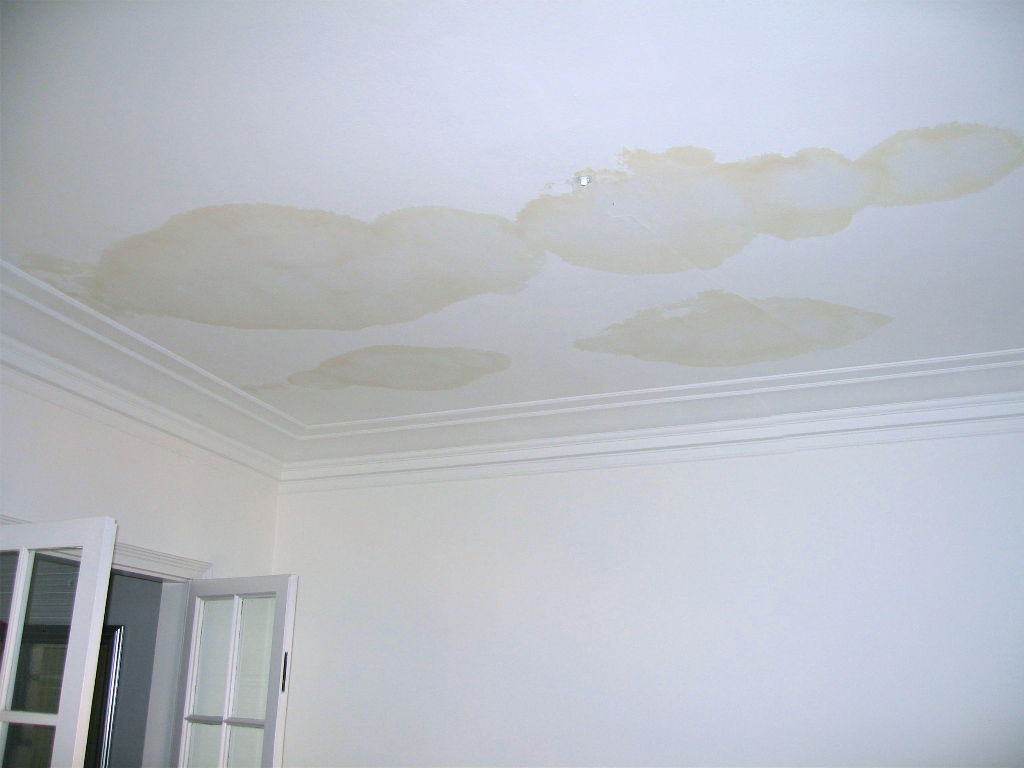Water stains on the ceiling are not only unsightly but can also be a sign of underlying issues in your home. Whether you’re dealing with a faint discoloration or a more prominent stain, understanding the root causes is essential to address the problem effectively. In this article, we’ll explore the common reasons behind water stains on ceilings and how to deal with them.

Understanding Water Stains on the Ceiling
Water stains on your ceiling are typically characterized by brown or yellowish discolorations. These stains can vary in size and intensity, but they all share a common cause: the infiltration of water from above. Water stains are a clear indicator that water has made its way into your home, and it’s essential to determine the source and remedy the issue promptly.
Common Causes of Water Stains
- Roof Leaks:
- Damaged Roof Shingles: Over time, roof shingles can deteriorate, crack, or be blown off by strong winds, leaving your roof vulnerable to leaks during rain or snowfall.
- Clogged Gutters: When gutters are clogged with debris, rainwater can overflow, seep under the shingles, and ultimately find its way into your home.
- Ice Dams: In colder regions, ice dams can form on the roof, preventing melting snow from draining properly. This trapped water can penetrate the roof and cause stains on the ceiling.
- Plumbing Leaks:
- Leaky Pipes: Faulty or damaged plumbing pipes can lead to water leaks that travel through your walls and eventually stain the ceiling below.
- Bathroom Fixtures: Leaks from toilets, sinks, bathtubs, or showers can often go unnoticed until water stains appear on the ceiling.
- Condensation Issues:
- Poor Ventilation: In areas with high humidity, like bathrooms or kitchens, inadequate ventilation can lead to condensation buildup, which may create water stains over time.
- Appliance Leaks:
- Water Heater Leaks: A faulty water heater can lead to leaks that affect the ceiling below.
- Refrigerator Leaks: If your refrigerator has a water or ice dispenser, a malfunction or damaged water line can lead to ceiling stains.
- Exterior Water Infiltration:
- Cracks or Gaps in Exterior Walls: Damage to the exterior walls or improper sealing around doors and windows can allow rainwater to enter your home.
How to Deal with Water Stains on Ceiling
Once you’ve identified the source of the water infiltration, it’s essential to take appropriate actions to address the issue:
- Repair the Source: The first step is to repair the root cause of the water infiltration. This may involve fixing a leaking roof, replacing damaged plumbing, or sealing exterior walls.
- Ceiling Stain Removal:
- Ceiling Paint*: For minor stains, you can often address the issue by applying a stain-blocking primer and repainting the affected area.
- Ceiling Panels: In more severe cases, it may be necessary to replace damaged ceiling panels or drywall.
- Preventive Measures:
- Regular Inspections: Conduct routine inspections of your roof, plumbing, and appliances to identify and address issues early.
- Gutter Maintenance: Keep your gutters clean and free of debris to ensure proper drainage.
- Proper Ventilation: Improve ventilation in high-humidity areas by installing exhaust fans or opening windows to reduce condensation.
- Consult Professionals: In many cases, it’s advisable to consult with professionals to assess and repair the damage. Roofers, plumbers, and contractors can provide expertise and ensure that the problem is thoroughly resolved.
Read too: How Is Radiant Ceiling Heat Installed
Conclusion
Water stains on the ceiling are not just cosmetic issues; they can indicate significant problems within your home. Understanding the common causes of water stains and taking prompt action to address them is essential to prevent further damage and maintain the integrity of your living space. By identifying the source and seeking professional help when needed, you can enjoy a dry and stain-free home.